View in other NatureServe Network Field Guides
NatureServe
Montana
Utah
Wyoming
Idaho
Wisconsin
British Columbia
South Carolina
Yukon
California
New York
Lesica's Bladderpod - Physaria lesicii
Other Names:
Lesquerella lesicii, Physaria lesicae
State Rank Reason (see State Rank above)
Lesica's bladderpod occurs only in Montana, where it is restricted to a few areas of limestone outcrops in the eastern Pryor Mountains. All known populations are on federal lands. While it occurs largely on steep terrain that is relatively inaccessible to humans, trampling and terracing through its habitat by wild horses may be negatively impacting the plant.
- Details on Status Ranking and Review
Population Size
Score1 - Moderate: Generally 10,000-100,000 individuals.
Range Extent
Score3 - Local Endemic or Very Small Montana Range: Generally restricted to an area <10,000 sq. miles (equivalent to the combined area of Phillips and Valley Counties) or <6 Sub-basins (4th code watersheds) Range-wide OR limited to one Sub-basin in Montana
Area of Occupancy
Score3 - Very Low: Generally occurring in 3 or fewer Subwatersheds (6th Code HUC’s).
Environmental Specificity
Score1-2 - Moderate to High.
Trends
ScoreNA - Rank factor not assessed.
Threats
Score2 - High: 31-70% of the populations are being negatively impacted or are likely to be impacted by one or more activities or agents, which are expected to result in decreased populations and/or habitat quality and/or quantity.
Intrinsic Vulnerability
Score1-2 - Moderate to High Vulnerability.
Raw Conservation Status Score
Score
11 to 13 total points scored out of a possible 16 (Rarity factors and threats only).
General Description
Lesica's Bladderpod is a short-lived perennial with a few, unbranched, prostrate to ascending stems that arise from an unbranched rootcrown and taproot. The basal leaves have petioles that are 1-3 cm long and spade-shaped blades that are shorter than the petiole with entire margins. The alternate stem leaves are much smaller, broadly lance-shaped, and without petioles. The foliage is sparsely covered with sessile, star-shaped hairs. Yellow, stalked flowers are borne at the tops of the stems in a narrow inflorescence that elongates as the fruit matures. Each flower has 4 separate petals, 4 separate sepals, and 4 long and 2 short stamens. The globose capsules, or siliques, have a short style on top and are borne on reflexed stalks.
Phenology
Flowering occurs in late June.
Diagnostic Characteristics
Lesquerella alpina differs in having fruits that are more ellipsoid and are borne on bent but ascending stalks.
L. alpina has leaves that are more strap-shaped and have indistinct stalks.
Lesquerella ludoviciana has globose fruits on recurved stalks very much like
L. lesicii; however, the leaves are narrowly lanceolate, and the fruits have a style greater than 2 mm long.
Lesica’s Bladderpod –
Physaria lesicii, SOC
*Pedicles are recurved in an arc, 4-11 mm long. Stems and pedicles are thread-like and flexuous (filiform).
*Fruits are globose, inflated, and 2-4 mm high
*Plants are less robust with thinner leaves and caudices. Plants grow at higher elevations, elative to Thick-leaf Bladderpod.
Thick-leaf Bladderpod –
Physaria pachyphylla, SOC
*Fruiting pedicels curve upwards (ascend), are 3-10 mm long, and less than 2 times longer than fruit.
*Fruits inflated, narrowly elliptic to globose (
not obviously appearing 2-lobed), and 3-6 mm tall. Style is 1-3 mm long, shorter than the mature fruit (silicle).
*Basal leaves have distinct petioles and blades. Basal blades are oblanceolate to orbicular in shape, nearly 1 mm thick, and cupped (
not folded).
*Plants grow on white to pinkish, limestone and gypsum soils on exposed ridges and slopes in the valley zone.
Species Range
Montana Range
Range Descriptions
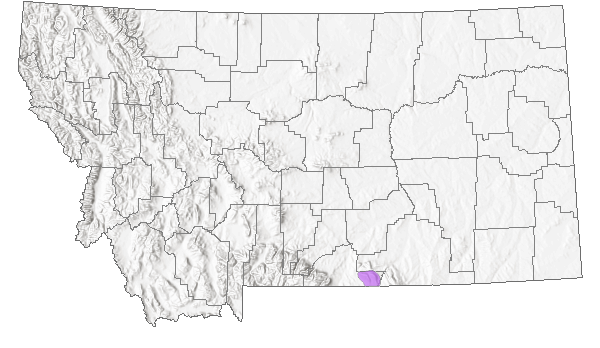
 Native
Native
Range Comments
Montana endemic restricted to the Pryor Mountains, Carbon County (Rollins 1995).
Observations in Montana Natural Heritage Program Database
Number of Observations: 32
(Click on the following maps and charts to see full sized version)
Map Help and Descriptions
Relative Density
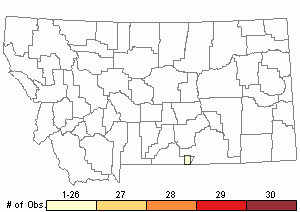
Recency
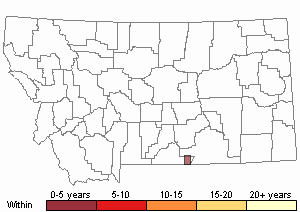

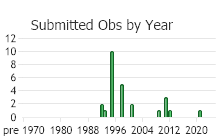
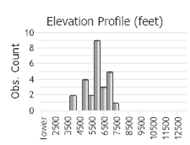 (Observations spanning multiple months or years are excluded from time charts)
(Observations spanning multiple months or years are excluded from time charts)
Habitat
The species occurs in two distinct vegetation types. One is woodlands with a sparse overstory of Rocky Mountain juniper and/or mountain mahogany, and widely scattered Douglas-fir. The shrub layer may have scattered Symphoricarpos oreophilus, Artemisia nova or A. tridentata. These woodlands are typically found on moderate to steep, usually warm slopes at the lower elevation limits of Douglas fir (5300-6300 feet).
The second habitat for Lesica's bladderpod is in bluebunch wheatgrass-cushion plant fellfields, with the dominant graminoids Agropyron spicatum, Poa secunda and Koeleria cristata. Low forbs usually dominate these habitats, which are usually on open, south-facing, gentle slopes of exposed ridge crests surrounded by forests of Pseudotsuga menziesii and Pinus flexilis.
Soils are typically derived from Madison limestone and are sandy and/or shallow with a high proportion of coarse fragments.
National Vegetation Classification System Groups Associated with this Species
Forest and Woodland
Low Elevation - Xeric Forest and Woodland
Montane - Subalpine Forest and Woodland
Shrubland
Foothills - Montane Shrubland
Grassland
Montane - Subalpine Grassland
Ecology
The microhabitats of L. lesicii have a high proportion (50-80%) of bare ground (Lesica 1995). Lesquerella lesicii may grow in partial shade, but is generally in full sun. Both frost heaving and wind exposure may limit the establishment of dense vegetation in this species' habitat, and steep slopes at some sites may promote moderate disturbance from soil movement (Lesica 1995). The sparse nature of the vegetation in this species' habitat suggests that it is a poor competitor. It appears that the bladderpod is facilitated by larger plants under the stressful conditions of the lower, hotter slopes, where it has been observed growing primarily beneath shrubs of Cercocarpus ledifolius and Symphoricarpos oreophilus, or within or immediately adjacent to clumps of Agropyron spicatum. A similar phenomenon has been reported by Greenlee and Callaway (1996) who found that Lesquerella carinata seedlings survived better under bunchgrass in a dry year, but survivorship was lower in plants associated with bunchgrass in a wet year. At higher elevations, where drought stress is lower, this species has been observed growing in open soil, usually away from larger plants (Lesica 1995).
Management
All known populations lie on the Pryor Mountain Wild Horse Range. The largest population is on steep, west-facing slopes that have been severely terraced by wild horses that produced parallel trails, 1-2 feet wide, every 3-6 feet of vertical distance. While the species was common above and below the trails, it did not occur on the trails, which were completely barren. Terracing of fragile steep slopes is common in this area of Pryor Mountain Wild Horse Range, and up to 20% of the habitat there has been lost to terracing (Lesica 1995). The wide trails are most likely caused by horses foraging for grass, although deer may also use these areas. Although Lesica's bladderpod is in no immediate danger of extirpation from the site, it appears that the presence of wild horses has had a negative impact on the populations (Lesica 1995).
Stewardship Responsibility
Threats or Limiting Factors
STATE THREAT SCORE REASON
Montana's population of Lesica's Bladderpod is entirely located in the Pryor Mountain Wild Horse range. Reported threats include a major component of the population located where concentrated trailing and trampling by feral horses has negative impacts on population plant density (MTNHP Threat Assessment 2021).
References
- Literature Cited AboveLegend:
 View Online Publication
View Online Publication Lesica, P., M.T. Lavin, and P.F. Stickney. 2012. Manual of Montana Vascular Plants. Fort Worth, TX: BRIT Press. viii + 771 p.
Lesica, P., M.T. Lavin, and P.F. Stickney. 2012. Manual of Montana Vascular Plants. Fort Worth, TX: BRIT Press. viii + 771 p. MTNHP Threat Assessment. 2021. State Threat Score Assignment and Assessment of Reported Threats from 2006 to 2021 for State-listed Vascular Plants. Botany Program, Montana Natural Heritage Program, Helena, Montana.
MTNHP Threat Assessment. 2021. State Threat Score Assignment and Assessment of Reported Threats from 2006 to 2021 for State-listed Vascular Plants. Botany Program, Montana Natural Heritage Program, Helena, Montana.
- Additional ReferencesLegend:
 View Online Publication
View Online Publication
Do you know of a citation we're missing? Al-Shehbaz, I. A. and S. L. O'Kane. 2002. Lesquerella is united with Physaria (Brassicaceae). Novon 12:319-329.
Al-Shehbaz, I. A. and S. L. O'Kane. 2002. Lesquerella is united with Physaria (Brassicaceae). Novon 12:319-329. Greenlee, J. T. and R. M. Callaway. 1996. Abiotic stress and the relative importance of interference and facilitation in montane bunchgrass communities in western Montana. American Naturalist 148:386-396.
Greenlee, J. T. and R. M. Callaway. 1996. Abiotic stress and the relative importance of interference and facilitation in montane bunchgrass communities in western Montana. American Naturalist 148:386-396. Lesica, P. 1995. Conservation status of Lesquerella lesicii in Montana. Unpublished report to the U.S. Forest Service and the Bureau of Land Management. Montana Natural Heritage Program. 16 pp. plus appendices.
Lesica, P. 1995. Conservation status of Lesquerella lesicii in Montana. Unpublished report to the U.S. Forest Service and the Bureau of Land Management. Montana Natural Heritage Program. 16 pp. plus appendices. Lesica, P., M.T. Lavin, and P.F. Stickney. 2022. Manual of Montana Vascular Plants, Second Edition. Fort Worth, TX: BRIT Press. viii + 779 p.
Lesica, P., M.T. Lavin, and P.F. Stickney. 2022. Manual of Montana Vascular Plants, Second Edition. Fort Worth, TX: BRIT Press. viii + 779 p. Rollins, R.C. 1995. Two Lesquerellas (Cruciferae) of south central and western Montana. Novon 5(1): 71-75.
Rollins, R.C. 1995. Two Lesquerellas (Cruciferae) of south central and western Montana. Novon 5(1): 71-75.
- Web Search Engines for Articles on "Lesica's Bladderpod"





